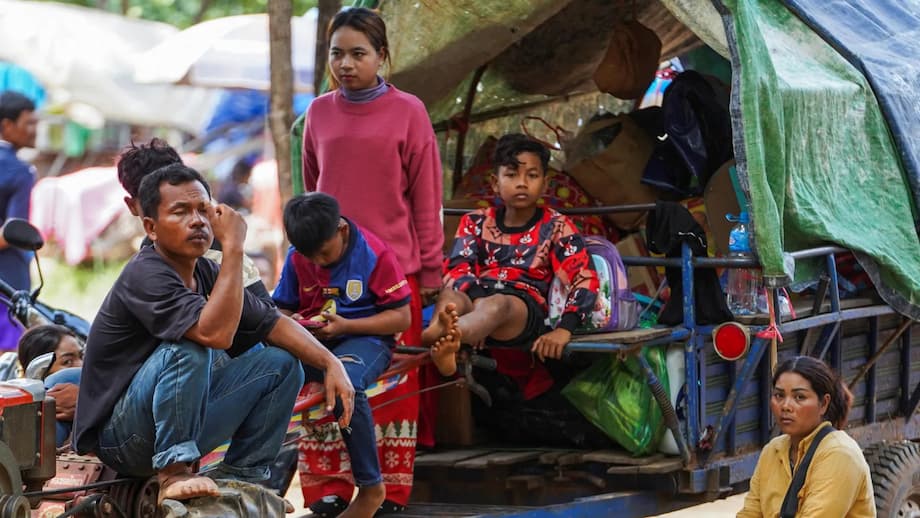Border Clashes Erupt as Online Nationalism Escalates
The Thailand-Cambodia border has once again become the epicenter of Southeast Asian tensions, with deadly clashes in July 2025 resulting in dozens of civilian casualties and the displacement of over 140,000 people. Yet, beyond the artillery fire and diplomatic standoffs, a parallel conflict is raging online. Social media platforms have become battlegrounds for national pride, historical grievances, and political maneuvering, fueling the flames of a century-old territorial dispute.
- Border Clashes Erupt as Online Nationalism Escalates
- What Sparked the Latest Border Crisis?
- Temples, Territory, and Nationalist Sentiment
- Social Media: The New Frontline of Conflict
- Political Feuds and Personal Rivalries
- Regional and International Repercussions
- Economic Fallout and Humanitarian Crisis
- Historical Roots and the Path Forward
- In Summary
As both governments scramble to contain violence on the ground, citizens from Thailand and Cambodia are waging a digital war, trading accusations and patriotic slogans across TikTok, X (formerly Twitter), Facebook, and other platforms. The online exchanges, often laced with misinformation and nationalist rhetoric, have deepened divisions and complicated efforts to de-escalate the crisis.
What Sparked the Latest Border Crisis?
The roots of the current conflict stretch back more than a century, to colonial-era treaties and ambiguous border demarcations imposed by the French. The most recent escalation began in May 2025, when a Cambodian soldier was killed in a brief skirmish. Tensions simmered for weeks, with both sides increasing their military presence and imposing travel restrictions along the 800-kilometer frontier.
The situation exploded in late July after a landmine blast injured Thai soldiers near the disputed Ta Muen Thom temple area in Surin province. Thailand responded with airstrikes and artillery barrages, while Cambodia fired rockets into Thai territory. The violence quickly spread to at least a dozen locations, with both countries accusing each other of initiating hostilities and targeting civilians.
According to Thailand’s health ministry, at least 19 people—mostly civilians—have been killed on the Thai side, with dozens more wounded. Cambodian authorities have reported at least one death and hundreds of evacuations. The humanitarian toll is mounting, as border villages are evacuated and infrastructure—including homes, schools, and hospitals—suffers extensive damage.
Diplomatic relations have deteriorated sharply. Both countries have expelled ambassadors, suspended trade, and accused each other of violating international law. Cambodia’s Prime Minister Hun Manet has appealed to the United Nations Security Council, while Thailand has declared martial law in several border districts, granting the military sweeping powers to impose curfews and restrict movement.
Temples, Territory, and Nationalist Sentiment
At the heart of the dispute are ancient temples and the land surrounding them—symbols of national identity and pride for both Thais and Cambodians. The Preah Vihear Temple, an 11th-century Hindu site perched atop a cliff, has been a flashpoint since the International Court of Justice (ICJ) awarded it to Cambodia in 1962. However, the surrounding territory remains contested, and the ICJ’s 2013 clarification of Cambodia’s sovereignty over the immediate area did little to resolve the broader dispute.
The Ta Muen Thom temple complex, another sacred site straddling the border, has seen repeated clashes. Both sides accuse each other of militarizing the area, laying landmines, and damaging heritage sites. These disputes are not merely about land—they are about history, culture, and the legitimacy of national narratives.
Nationalist pressures run high in both countries. In Thailand, political instability and economic woes have made the government sensitive to accusations of weakness. In Cambodia, the ruling Cambodian People’s Party (CPP) has long used nationalist messaging to consolidate support, especially during times of internal dissent or economic hardship.
These dynamics are amplified by social media, where users invoke historical grievances and accuse the other side of cultural theft. Thai nationalists decry what they call “Claimbodia,” while Cambodians refer to Thais as “Siamese thieves.” Disputes over traditional dances, wedding attire, and even the naming of martial arts (Muay Thai versus Kun Khmer) have become flashpoints for online outrage.
Social Media: The New Frontline of Conflict
As artillery shells fall along the border, a different kind of battle is being fought online. Social media platforms have become echo chambers for nationalist sentiment, misinformation, and digital activism. Comment sections on posts about the conflict are flooded with competing hashtags—#CambodiaOpenedFire, #ThailandOpenedFire—and viral videos purporting to explain or justify each side’s actions.
According to reports from BBC and MSN, young people in both countries are especially active in these digital skirmishes, often backing their governments’ official narratives and attacking perceived enemies. Viral incidents—such as a video showing a Thai man slapping a Cambodian worker—have spilled over into real-world violence, highlighting the dangerous feedback loop between online rhetoric and offline actions.
Journalists’ associations from both countries have issued joint statements urging social media users to consider the consequences of their posts. Yet, the rapid spread of unverified information and emotionally charged content makes moderation difficult. As Wilaiwan Jongwilaikasaem, a journalism professor at Thammasat University, told BBC Thai, “We’re now beginning to see violence, even among groups with no prior conflict between them.” She described the phenomenon as a “war of hate” waged by nationalistic influencers.
Social media has also become a tool for political leaders. Former Thai Prime Minister Thaksin Shinawatra and Cambodia’s ex-leader Hun Sen have traded barbs on X, each accusing the other of betrayal and aggression. The leaking of a private phone call between Hun Sen and Thai Prime Minister Paetongtarn Shinawatra—where she appeared to criticize her own military—sparked public outrage and led to her suspension by Thailand’s Constitutional Court. The incident not only embarrassed the Shinawatra family but also shattered a long-standing personal relationship that had previously helped keep tensions in check.
Political Feuds and Personal Rivalries
The current crisis is as much about personal and political rivalries as it is about territory. The once-close relationship between Hun Sen and the Shinawatra family has unraveled, with both sides now using the conflict to shore up domestic support and discredit opponents.
Hun Sen, who ruled Cambodia for nearly four decades before handing power to his son Hun Manet in 2023, remains a powerful figure as President of the Senate and the ruling party. His government has a history of using nationalist rhetoric and foreign disputes to distract from internal problems, including economic hardship and allegations of corruption. Analysts from the Australian Strategic Policy Institute (ASPI) argue that Hun Sen’s recent actions fit a pattern of stoking external conflicts to tighten his grip on power.
Thailand, meanwhile, is grappling with political instability and economic stagnation. The suspension of Prime Minister Paetongtarn Shinawatra has left a shaky coalition government struggling to project strength. Nationalist factions have seized on the border conflict to challenge civilian leadership and rally public support.
These internal pressures have made compromise difficult. As one Thai social media user put it, “Hun wants dispute and war, he wants to solidify his and his son’s future position in Cambodia and he needs to have a bigger enemy.”
Regional and International Repercussions
The border clashes have reverberated beyond Thailand and Cambodia, raising concerns about regional stability and the effectiveness of multilateral institutions like ASEAN. Malaysia, as current chair of ASEAN, has offered to mediate, and the United States, China, and the European Union have all called for restraint and dialogue. However, Thailand has insisted on bilateral negotiations, limiting the bloc’s ability to intervene.
The United Nations Security Council convened an emergency session to address the crisis, but a lasting solution remains elusive. Both countries have rejected third-party mediation for now, preferring to manage the dispute through direct talks—despite repeated breakdowns in communication and trust.
China, the largest trading partner for both Thailand and Cambodia, has quietly urged de-escalation, wary of instability along its southern flank. The U.S., which has a security treaty with Thailand, has called for an immediate cessation of hostilities and respect for international law. The episode is testing ASEAN’s founding principle of avoiding conflict among member states and its ability to manage sudden security crises.
Economic Fallout and Humanitarian Crisis
The fighting has already taken a heavy toll on the economies of both countries. Bilateral trade, which reached nearly $4 billion in 2024, has ground to a halt as border crossings are sealed and martial law disrupts supply chains. Energy exports, agricultural shipments, and manufacturing operations in the affected provinces face severe disruption, with companies scrambling to reroute shipments and comply with new security regulations.
The humanitarian situation is dire. More than 140,000 people have been displaced, with many seeking shelter in makeshift camps or fleeing to urban centers. Provincial authorities are struggling to provide food, medical care, and basic services to evacuees. The risk of landmines—millions of which remain from past conflicts—adds to the danger, especially as both sides accuse each other of laying new mines in disputed areas.
For ordinary people, the conflict means lost livelihoods, disrupted education, and the constant threat of violence. Cambodian workers trapped by Thai border closures face shortages of essential goods, while Thai villagers near the frontier live in fear of rocket attacks and airstrikes.
Historical Roots and the Path Forward
The Thailand-Cambodia border dispute is deeply rooted in the region’s colonial history. The Franco-Siamese treaties of the early 20th century left many sections of the border ill-defined, with maps that are still contested today. The Preah Vihear and Ta Muen Thom temples have become symbols of national sovereignty, but also of the enduring ambiguities that fuel periodic flare-ups.
Past efforts to resolve the dispute—through the ICJ, bilateral talks, and ASEAN mediation—have produced only partial solutions. Nationalist sentiment, political instability, and economic pressures continue to undermine trust and make compromise elusive. As analysts from the Geopolitical Monitor note, the most likely outcome is a prolonged stalemate or “frozen conflict,” with both sides avoiding a full-scale war but unable to reach a lasting settlement.
Yet, the rise of social media has changed the dynamics of the conflict. Digital platforms amplify nationalist voices, spread misinformation, and make it harder for leaders to de-escalate without appearing weak. The online “war of hate” risks entrenching divisions for a new generation, making reconciliation even more difficult.
In Summary
- Deadly clashes along the Thailand-Cambodia border in July 2025 have killed dozens and displaced over 140,000 people, reviving a century-old territorial dispute.
- Social media has become a key battleground, with users from both countries trading accusations, spreading misinformation, and fueling nationalist sentiment.
- The conflict centers on disputed temples and territory, with historical grievances dating back to colonial-era treaties and ambiguous border demarcations.
- Political rivalries and personal feuds between leaders—especially between Cambodia’s Hun Sen and Thailand’s Shinawatra family—have exacerbated tensions.
- Efforts at mediation by ASEAN, the UN, and major powers have so far failed to produce a ceasefire, as both sides prefer bilateral negotiations.
- The economic and humanitarian toll is severe, with trade disrupted, martial law imposed, and civilians facing displacement and danger from landmines.
- Analysts warn that without de-escalation, the conflict could become a prolonged “frozen” dispute, with social media continuing to inflame divisions.




